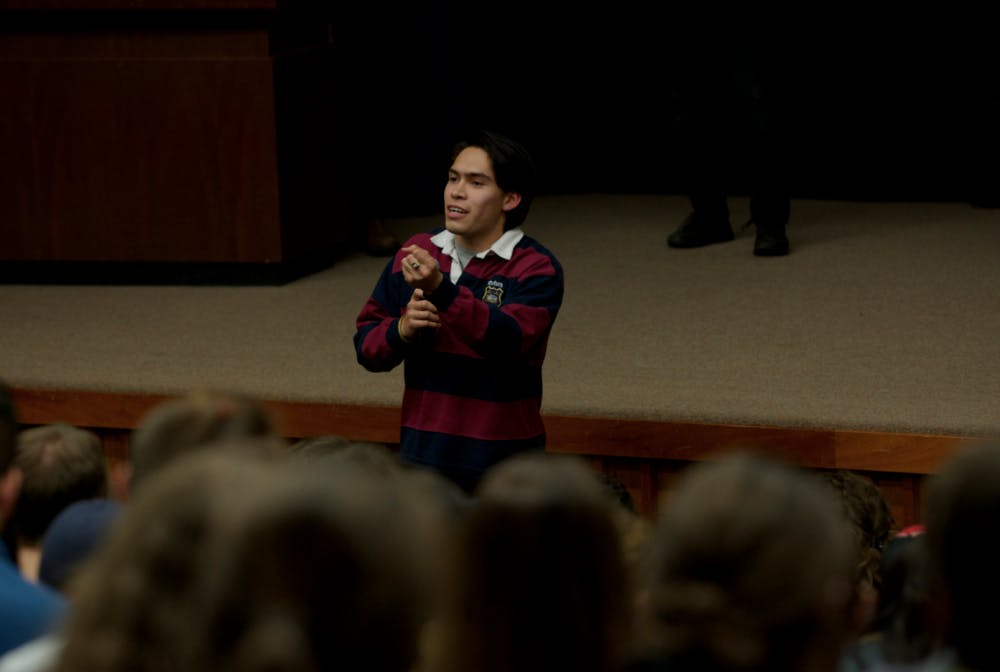On Monday, Nov. 30, Interim Chief Diversity Officer Miguel A. Fernández and Associate Professor of American Studies Roberto Lint Sagarena, also Director for the Center for Comparative Study of Race and Ethnicity, hosted a town hall discussion in Dana Auditorium. The discussion was focused on cultural appropriation, the need for a respectful and mindful community and the need for students to be educated about race, culture and history.
Fernández acknowledged in his email to the College that an impetus for the discussion was an incident in which a white student wearing a sombrero in Proctor dining hall offended a Latino student.
But cultural appropriation and racial insensitivity has been at the forefront of campus conversation since Halloween — a social media campaign against culturally appropriating costumes, the performance of Felly, a white rapper, at the College on Friday, and as Fernandez noted, the anti-latino and anti-muslim rhetoric of Republican primary candidates, most notably Donald Trump.
“Some of you will be oblivious to what I am about to discuss and others of you will have read or participated in social media discussions over the weekend about sombreros and cultural appropriation,” Fernández wrote. “Much of the discussion took a very negative turn, showing intolerance, misunderstanding and discrimination.”
The meeting began with an examination of what cultural appropriation is (when a culture adopts elements of another culture) and when it becomes offensive. One student asked whether the administration had a position on the acceptability of cultural appropriation. In response, Fernández cited the College’s community standards. The handbook calls for both “cultivating respect and responsibility for self, others and our shared environment” and “fostering a diverse and inclusive community committed to civility, open-mindedness and finding common ground.”
“[There’s] the argument that just because we can burn the American flag still means that we shouldn’t. I think of that as being applicable to free speech as well. We have the right to do all sorts of things, but maybe we shouldn’t — out of self respect and respect for our community,” Sargena said.
Fernández summarized the previous town hall discussion, in which attendants discussed the cultural symbolism of the sombrero.
“I think the discussion came down to: if a group finds something offensive there is a historical reason for that, then you really ought to question why you’re doing something,” said Fernández.
Students wondered if College policy could be changed to mitigate offensive actions or statements. One member of the faculty responded that he believed including controls on speech and dress in college policy is too subjective and would privilege certain voices.
Another student pointed out that the 1st amendment rights are not guaranteed at private organizations like corporations, religious groups or colleges. The College can design community standards or put restrictions on freedom of speech if it decides that is appropriate for its mission.
The discussion then moved to the issue of the ignorance of white students towards cultural and racial sensitivities. Multiple students noted that it was not the responsibility of students of color to educate other students on their cultures. Others called on the administration to institute programming, whether it be required reading or discussions during orientation week, that would encourage students to engage in what it means to live in a diverse community. Suggestions for how to self-educate were varied — while some students pointed to the internet and Google as a powerful tool for finding information on racial and cultural sensitivities and history, many professors in attendance emphasized the superiority of academic sources and the importance of using the faculty as a resource.
Nicolas Mendia ’16 shared his experience with confronting the student wearing the sombrero, but emphasized that this was only one of many incidents that had affected him this semester. He related the student’s resistance to take off her sombrero and her conviction that she was not culturally appropriating, and that he had felt afraid upon realizing that he could have faced repercussions for approaching the student had she felt threatened.
“This was the third incident of racism I had experienced this semester,” Mendia said. “The Otter Nonsense ‘kissed her doorman’ and the soccer team’s ‘Mexican jumping bean’ posters were the two others. These incidents made me afraid. However small you see them, I spent the next few weeks scared because someone on this campus considered this behavior okay, not unlike the much worse incidents of targeted racism I faced in my community growing up.”
“So when you say, ‘You’re too sensitive’ or ‘have a thicker skin,’ I need you to understand, I have had my thicker skin. I am exhausted. I have had enough. These incidents have been eating away at me all semester, made me afraid to go to class, made me angry with myself and the strangers around me because I do not know whether you are the ones doing these transgressions. It’s incidents like these that forced me to move off campus because I do not feel safe in this community anymore. I don’t want to be here anymore.”
Once the space reached capacity, students, staff and administrators were turned away, including Russell J. Leng ‘60 Professor of International Politics and Economics Allison Stanger.
“It was a missed opportunity to build community that can easily be put right,” Stanger said. “As soon as possible, we should hold another meeting in a larger venue and encourage everyone to attend. Gathering everyone together in this way is of the utmost importance. It made me proud of who we are to see so many people show up yesterday.”
Fernández concluded the meeting by saying that he hoped that this would not be the end of the discussion and that he hoped to host another forum in the coming weeks.
Students Discuss Appropriation, Race

Comments



